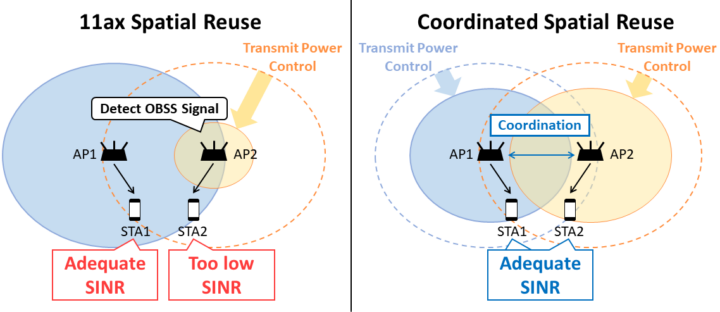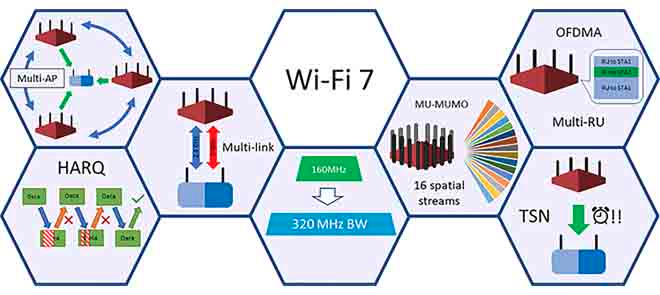I still don’t own a WiFi 6 router, but MediaTek has already started to demonstrate WiFi 7 (802.11be) to customers with solutions based on upcoming Filogic 802.11be processors which deliver “super-fast speeds and low latency transmission” and provide a “true wireline/Ethernet replacement for super high-bandwidth applications”.
The company goes on to explain that Wi-Fi 7 relies on the same 2.4GHz, 5GHz, and 6GHz frequencies as WiFi 6/6E, but can still provide 2.4x higher speeds than Wi-Fi 6, even with the same number of antennas, since WiFi 7 can utilize 320Mhz channels and support 4K QAM (quadrature amplitude modulation) technology.
There’s limited information about MediaTek Filogic 802.11be WiFi 7 processors since it will take a few more years before becoming available, but we can find more details in a document entitled “Current Status and Directions of IEEE 802.11be, the Future Wi-Fi 7” from IEEE Xplore.
Here are some of the key features expected in WiFi 7:
- Up to 40 Gbps link
- Bandwidth up to 320 MHz and beyond
- Order of modulation up to 4K-QAM
- Up to 16x spatial streams in MU-MIMO
- Enhanced Distributed Channel Access (EDCA) with 802 TSN (Time-sensitive Networking) features for real-time applications
- Latency below 5 ms suitable for gaming
- Enhanced OFDMA for better resource allocation
- Multi-link operation favorable for both tremendous data rates and extremely low latency
- Channel sounding optimization to reduce overhead
- Introduction of HARQ (Hybrid Automatic Repeat Request) which “exploits the information from the previous tries. The receiver combines the signals from several transmission attempts, which increases SNR and, consequently, the probability that the receiver decodes the packet correctly.”
- Non-orthogonal Multiple Access (NOMA) to increase peak throughput and improve efficiency by making an access point (AP) serve multiple stations/clients (STAs) simultaneously in the same baseband by allocating portions of the total transmission power for each STA
- Multi-AP cooperation with techniques such as coordinated spatial reuse (CSR) or coordinated OFDMA (CO-OFDMA) in dense deployments

Note that the features above are still being under consideration since the 802.11be standard has yet to be ratified and there may be changes.
The higher speeds and lower latency will help provide a better quality of service for some existing applications such as high-quality video calls, 4K/8K TV entertainment, real-time gaming, and more, and MediaTek expects future AR/VR applications to fully benefit from the new wireless standard.
MediaTek says products with Wi-Fi 7 are expected to hit the market starting in 2023, but the development timeline from the May 2020 document above expects the final amendment to occur in May 2024. I’ve seen companies launch products based on draft specifications before, but obviously, there’s a certain level of risk as the products may end up not being fully compatible depending on how the draft specifications are amended.
Thanks to TLS for the tip.

Jean-Luc started CNX Software in 2010 as a part-time endeavor, before quitting his job as a software engineering manager, and starting to write daily news, and reviews full time later in 2011.
Support CNX Software! Donate via cryptocurrencies, become a Patron on Patreon, or purchase goods on Amazon or Aliexpress






Thanks for the detailed article Jean-Luc, but please, I see this often, it’s not “faster speed”. It’s either “faster transfer” or “higher speed”. A speed or a rate is a measure of a derivative. It’s neither fast nor slow, as it doesn’t move, it’s just a measure. A movement or transfer is fast or slow depending on how it evolves over time. For a fast speed you need it to change over time, implying you’d be talking about an acceleration, which usually does not make sense (especially out of such a particular context).
Interesting. Never thought of this.
https://c.tenor.com/tvFWFDXRrmMAAAAC/blow-mind-mind-blown.gif
But you’re right.
I bet the coming mobile and WiFi standards will practically be the same 😂. Modulation-wise there is a lot of overlap.
“Up to 40 Gbps” sounds great, but will manufacturers pair wifi 7 with 10Gbe ports?
In real world scenarios the bandwidth will be split up between 10+ devices that will all be more than a couple of feet from the access point.
My current gaming PC has issues passing VR games to my Oculus 2 via wifi 6 in a “standard” home environment. I get better results when I use an Ethernet cable to my router from the PC. I can only assume it would be even better if my access point had 10Gbe like my PC does.